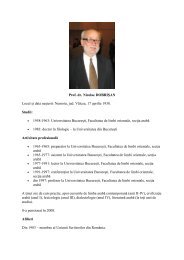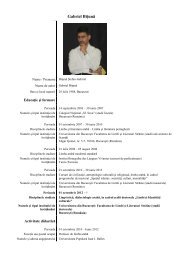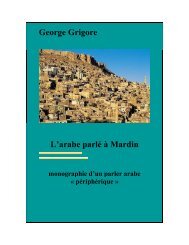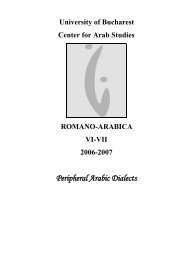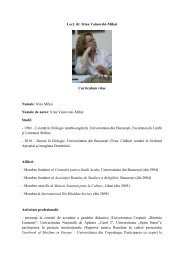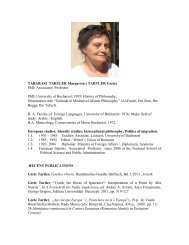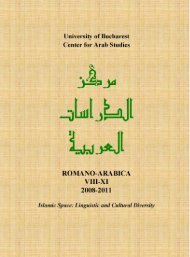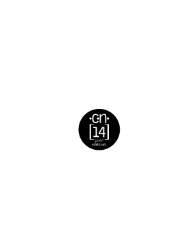Arabic Linguistics
Arabic Linguistics
Arabic Linguistics
You also want an ePaper? Increase the reach of your titles
YUMPU automatically turns print PDFs into web optimized ePapers that Google loves.
where the pronominal suffix -hā refers to dār, preventing the permissibility<br />
of a construction like * kāna s}āh}ibuhā fī l-dār in order to avoid the occurrence of<br />
a pronoun before the noun it refers to;<br />
7. ayna kāna Zaydun<br />
8. ayna takun akun,<br />
where the syntactic peculiarity of both the interrogative particle and the<br />
conditional particle effectively requires the prepositing of the predicate; and<br />
9. kāna s}āh}ibī „aduwwī,<br />
where the noun of kāna necessarily has to come first because the final<br />
vowels, which would have normally identified the noun and the predicate, do not<br />
appear on any of them due to the presence of the first person singular suffix, -ī.<br />
III. mā zāla:<br />
The model sentences 1 and 2 are applicable to mā zāla and hence, unlike<br />
sentence 3, did not require much attention from the grammarians. Preposing the<br />
predicate with mā zāla constructions gives rise to two major issues: the type of<br />
negative particle that precedes zāla, and the possibility of having the preposed<br />
predicate interpose between mā and zāla. The closest parallel to sentence 3 is<br />
10. qā‟iman mā zāla Zaydun<br />
and is admissible by the Kufans other than Farrā‘, but is inadmissible by the<br />
Basrans. A similar construction rarely quoted in the sources,<br />
10a. qā‟iman mā kāna Zaydun, 7<br />
implies the application of reverse analogy whereby the umm particle is<br />
compared to one of its sisters.<br />
Further variation on sentence 10 is achieved by changing the negative particle<br />
preceding zāla. Most sources consider lam, lan, and lā 8 in the following constructions:<br />
11. qā‟iman lam yazal Zaydun.<br />
12. qā‟iman lan yazāla Zaydun.<br />
13. qā‟iman lā yazālu Zaydun.<br />
These constructions are admissible by the Basrans and the Kufans alike, but<br />
not by Farrā‘, and the first two are also inadmissible by ‗Abdallah b. Sulaymān<br />
known as Duraywid. Furthermore, when construction 11 has kāna we have<br />
another instance of reverse analogy:<br />
11a. qā‟iman lam yakun Zaydun. 9<br />
Astarābādī also explores the possibility of introducing the exceptive particle<br />
illā to the last sentence:<br />
11b. illā qā‟iman lam yakun Zaydun. 10<br />
and concludes that it is not permissible.<br />
As for construction in which the predicate interposes between mā and zāla,<br />
14. mā qā‟iman zāla Zaydun,<br />
43



